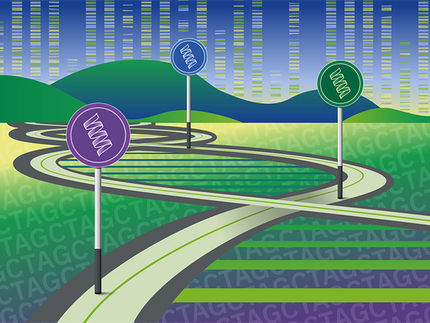Computational biologists use evolution-tracking method to discover 300 new human genes
Using supercomputers to compare portions of the human genome with those of other mammals, researchers at Cornell have discovered some 300 previously unidentified human genes, and found extensions of several hundred genes already known. The discovery is based on the idea that as organisms evolve, sections of genetic code that do something useful for the organism change in different ways.
The research is reported by Adam Siepel, Cornell assistant professor of biological statistics and computational biology, Cornell postdoctoral researcher Brona Brejova and colleagues at several other institutions in Genome Research.
The complete human genome was sequenced several years ago, but that simply means that the order of the 3 billion or so chemical units, called bases, that make up the genetic code is known. What remains is the identification of the exact location of all the short sections that code for proteins or perform regulatory or other functions.
More than 20,000 protein-coding genes have been identified, so the Cornell contribution, while significant, doesn't dramatically change the number of known genes. What's important, the researchers say, is that their discovery shows there still could be many more genes that have been missed using current biological methods. These methods are very effective at finding genes that are widely expressed but may miss those that are expressed only in certain tissues or at early stages of embryonic development, Siepel said.
"What's exciting is using evolution to identify these genes," Siepel said. "Evolution has been doing this experiment for millions of years. The computer is our microscope to observe the results."
Siepel and colleagues set out to find genes that have been "conserved" - that are fundamental to all life and that have stayed the same, or nearly so, over millions of years of evolution. The researchers started with "alignments" discovered by other workers - stretches up to several thousand bases long that are mostly alike across two or more species. Using large-scale computer clusters, including an 850-node cluster at the Cornell Center for Advanced Computing, the researchers ran three different algorithms, or computing designs - one of which Siepel created - to compare these alignments between human, mouse, rat and chicken in various combinations.
Over millions of years, individual bases can be swapped - C to G, T to A, for example - by damage or miscopying. Changes that alter the structure of a protein can kill the organism or send it down a dead-end evolutionary path. But conserved genes contain only minor changes that leave the protein able to do its job. The computer looked for regions with those sorts of changes by creating a mathematical model of how the gene might have changed, then looking for matches to this model.
After eliminating predictions that matched already known genes, the researchers tested the remainder in the laboratory, proving that many of the genes could in fact be found in samples of human tissue and could code for proteins. The researchers were sometimes able to identify the proteins by comparison with databases of known proteins. The discovered genes mainly have to do with motor activity, cell adhesion, connective tissue and central nervous system development, functions that might be expected to be common to many different creatures.
Most read news
Topics
Organizations

Get the analytics and lab tech industry in your inbox
By submitting this form you agree that LUMITOS AG will send you the newsletter(s) selected above by email. Your data will not be passed on to third parties. Your data will be stored and processed in accordance with our data protection regulations. LUMITOS may contact you by email for the purpose of advertising or market and opinion surveys. You can revoke your consent at any time without giving reasons to LUMITOS AG, Ernst-Augustin-Str. 2, 12489 Berlin, Germany or by e-mail at revoke@lumitos.com with effect for the future. In addition, each email contains a link to unsubscribe from the corresponding newsletter.
























































